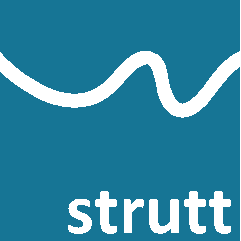
Strutt|Environmental Noise|CNOSSOS Barrier + Ground Attenuation inserts attenuation (dB) into the active row of the worksheet calculated using the CNOSSOS EU noise propagation model.
Note that either the CNOSSOS Barrier loss or the CNOSSOS Ground Attenuation loss should be applied - not both.
The CNOSSOS barrier loss also includes the ground-reflected component on either side of the barrier.
As a test for whether the barrier effect should be applied, check whether the (signed) path difference `delta` for the diffraction edge (i.e. in the illuminated zone `delta` is negative) - if the path difference is `delta < -lambda/20` where `lambda` is the wavelength of sound at the frequency of interest, then diffraction may be neglected and the ground attenuation calculation should be used (Rayleigh's Criterion).
The CNOSSOS barrier calculation is the combination of the following terms:
CNOSSOS is developed for propagation above varying-height ground planes, and uses the concept of equivalent height `z_s,z_r` - i.e. the source and receiver heights for calculating the ground effect are defined relative to the average height of the ground plane, and are not necessarily the same as the local source/receiver heights `h_s,h_r`:
In general, the source-side ground plane and the receiver-side ground plane will be at different angles of inclination relative to the barrier.
E.g. in the following example, the dashed red line is the source-barrier average ground plane, and the dashed green line is the barrier-receiver average ground plane:
To simplify the calculation, Strutt requires the user to input the following parameters:
The CNOSSOS barrier calculation also uses the ground factors `G_(w,S)` and `G_(w,R)` over the source and receiver ground planes (i.e. proportion of porous ground). In cases where the ground plane consists of multiple ground types, the average `bar G` (weighted by the extent of each ground type) should be used.
Typical values of `G` are as follows:
The CNOSSOS model predicts the attenuation under neutral (or "homogenous") atmospheric conditions (constant sound speed where sound propagation paths are straight rays), as well as adverse (or "favourable") conditions where a sound speed gradient results in curved ray paths.
The effect of the curved ray paths is to increase the average propagation height and reduce the strength of the barrier and ground effects. The curved ray paths can also result in the receiver changing from shadow zone to illuminated zone under adverse conditions, e.g. as shown in the 2nd Case below, where although the barrier intersects the straight-line from source to receiver, the curved ray paths would go over the top of the barrier:
The path difference `delta` under adverse conditions is calculated as per neutral conditions, except using the length of the curved ray paths, which are calculated as follows:
`hat (MN) = 2 Gamma sin^-1((MN)/(2 Gamma))`, where:
`hat (MN)` is the length of the curved path from point M to point N
`SR` is the straight line distance from point M to point N
`Gamma` is the curvature of the path, calculated as: `Gamma = Max(1000,8 d_(SR))`
`d_(SR)` is the source-receiver slant distance
For the special case (Case 3 above) where the line of sight from source to receiver lies above the barrier, the path difference is calculated using point `A`, the vertical projection of the barrier height to the line-of-sight from source to receiver, as follows:
`delta = 2 hat (SA) + 2 hat (AR) - hat (SO) - hat (OR) - hat (SR)`
The diffraction attenuation under neutral or adverse conditions is calculated using the same formula; only the path difference is different, as explained above:
`Delta_("diff") = {(10 C_H log_10 (3+40/lambda C_D delta) " if " 40/lambda C_D delta >= -2),(0 " otherwise") :}`
where:
`lambda` is the wavelength
`delta` is the path difference (calculated for neutral or adverse conditions as discussed above)
`C_D` is a coefficient for double diffraction:
The overall barrier + ground loss `A_("diff")` is calculated as follows:
`A_("diff")=Delta_("diff"(S,R))+Delta_(ground(S,O))+Delta_(ground(O,R))`
I.e. pure diffraction loss + ground effect (source side) + ground effect (receiver side).
The ground effect terms are calculated using the image source/receiver diffraction terms plus the ground reflection terms for the source/receiver ground planes - i.e. effectively weighting the ground reflection by the strength of the diffracted path to/from the image source/image receiver.
`Delta_(ground(S,O)) = 20 log_10(1+(10^(A_(ground(S,O))/20)-1)*10^((Delta_("diff"(S prime,R))-Delta_("diff"(S,R)))/20))`
`Delta_(ground(O,R)) = 20 log_10(1+(10^(A_(ground(O,R))/20)-1)*10^((Delta_("diff"(S,R prime))-Delta_("diff"(S,R)))/20))`
`Delta_("diff"(S,R))` is the pure diffraction loss from source to receiver
`Delta_("diff"(S prime,R)` is the pure diffraction loss from image source to receiver
`Delta_("diff"(S,R prime))` is the pure diffraction loss from source to image receiver
`A_(ground(S,O)` and `A_(ground(O,R))` are calculated using the CNOSSOS Ground Attenuation calculation.
References: